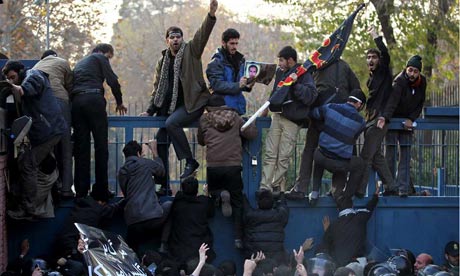PHOTO: Crowd storms British Embassy in Tehran, November 2011
Julian Borger reports for The Guardian:
Britain’s foreign secretary, Philip Hammond, will formally reopen the UK embassy in Tehran this weekend, nearly four years after it was shut down as a result of a mob attack.
The Iranian embassy in London will be reopened at the same time, as part of a rapid warming of relations between Iran and the west following the agreement reached on 14 July on the future of the Iranian nuclear programme. Hammond’s Tehran trip, the first by a British foreign secretary in nearly 14 years, comes soon after visits from the French and Italian foreign ministers, Germany’s vice-chancellor, and the EU’s foreign policy chief.
Hammond will be accompanied on his visit by a handful of British business leaders as well as the Foreign Office political director, Sir Simon Gass, who represented Britain in the marathon talks leading up to the July nuclear agreement.
The UK ambassador’s residence and some of the embassy buildings in Tehran have been restored since they were stormed and ransacked in November 2011 by a crowd of activists rallied by hardliners angry at the UK’s imposition of sanctions on Iran. The mob included members of the paramilitary basij brigades, under the control of the Revolutionary Guards. The protesters climbed the walls of the embassy, burned the British flag and looted property from the living quarters.
The reopened British embassy will be staffed initially by a small number of diplomats led by Ajay Sharma, who has been non-resident chargé d’affaires since 2013. A new British ambassador has been chosen but not yet announced. Before the storming of the British embassy in Tehran, Iran’s parliament, the Majlis, voted to downgrade bilateral relations from ambassadorial to the rung below, the level of chargé d’affaires. Majlis approval is likely to be needed to restore ambassadorial ties.
It was initially expected full diplomatic relations would be resumed soon after each country named non-resident chargés d’affaires two years ago, but a number of technical issues held up progress. When British diplomats prepared to abandon the embassy and residence, they ripped out communications devices and other electronic equipment and destroyed much of it. The UK wanted to replace the hardware before reopening but was constrained by an Iranian rule limiting the weight of any single diplomatic bag to 15 kg.
Furthermore, in order to authorise the renewed issue of visas to Iranian applicants in Tehran, the UK Home Office insisted that a bilateral agreement was signed allowing for the repatriation of Iranian nationals in Britain who had overstayed their visas. However, Iranian law forbids acceptance of Iranians deported from foreign governments against their will.
After months of delay, and increasing alarm in London that Britain’s European competitors were beating the UK in the race for the Iranian market ahead of the expected lifting of sanctions, compromises were found on both outstanding issues. It was decided to reopen the British embassy before it was fully kitted out and rewired. The details of the compromise over returning visa-less Iranians have yet to be released.
The conclusion of the Joint Comprehensive Plan of Action, in which Iran accepted limits on its nuclear programme while the UK and five other major powers agreed to lift sanctions, boosted London’s determination to overcome the remaining obstacles and led to intensified negotiation between the foreign office and the home office on how to resolve the visa issue, paving the way for Hammond’s visit.

